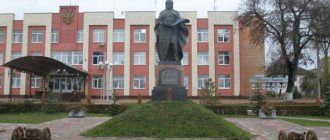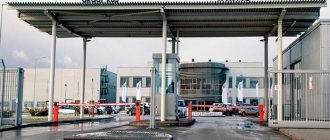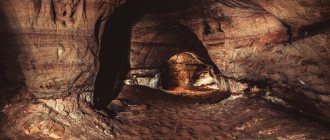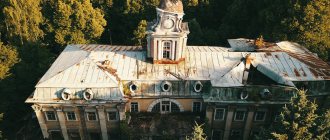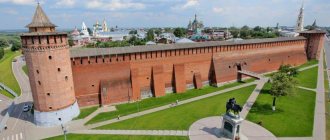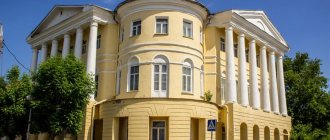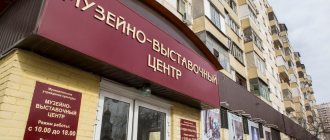Borovsk is the administrative center of the Borovsky district, which in 2000 received the status of a historical city of Russia.
Surrounded by forests, Borovsk is located on the hills on both banks of the Protva River, approximately 20 km from the Balabanovo station of the Kyiv direction of the Moscow Railway and 84 km southwest of Moscow. The city covers an area of about 1044 hectares. It is connected by highways to the cities of Balabanovo, Ermolino, Obninsk and Maloyaroslavets, as well as Medynsky and Zhukovsky districts and the Moscow region.
Brief historical background
Presumably, Borovsk arose in the 13th century. The first mention of the city is contained in the spiritual charter of Grand Duke Ivan Ivanovich II the Red, dated 1358, but the ceramics found at the Borovsky settlement date back to an earlier time, from the 11th to the 13th centuries, which indicates the existence of an ancient Russian settlement here. Archaeological excavations and surveys of modern Borovsk (2003) also show that in the 13th-14th centuries, at a distance of 500-800 meters from each other, there were settlements on the left bank of the Protva River (“Petrova Gora”) and on the right bank (at the ancient settlement and in the area of Kosovo ravine).
Around 1378, Dmitry Donskoy transferred Borovsk, along with several volosts, to Prince Vladimir Andreevich the Brave and the city became one of the centers of the Serpukhov-Borovsk principality, which existed until the 3rd quarter of the 15th century. In 1480, Ivan III, who owned the city, prepared troops near Borovsk for battle with the Horde.
In the 17th century, Borovsk became the scene of the tragedy of the Old Believers. Archpriest Avvakum was exiled here, and his comrades, the noblewoman Morozova and her sister Princess Urusova, were placed in the Borovsky prison (and there they were killed).
Since 1776, Borovsk has been a district town of the Borovsky district of the Kaluga governorate (since 1796 - the Kaluga province). In 1777, the coat of arms of Borovsk was established.
During the Patriotic War of 1812, the city and the Pafnutiev Monastery were burned and devastated by the French. In May 1857, the city was badly damaged by fire - 150 residential buildings, 200 shops and several churches burned down.
From 1880 to 1891, K. E. Tsiolkovsky lived in Borovsk, working here as a teacher. Around the same time, the religious thinker N. F. Fedorov lived and taught here.
Since 1929, the city has been the center of the Borovsky district of the Kaluga district of the Moscow region (since 1944 - the Kaluga region).
Religious shrines of Borovsk
There are many churches and temples in the city. But it all began with the construction of a monastery by the Monk Paphnutius.
Pafnutev-Borovskaya monastery
- Address: st. Dmitrova, 1.
The monastery was founded in 1444. It is located on a hill at the confluence of the Isterma and Protva rivers. In 1467, a new stone cathedral was built on the site of the first, Church of the Nativity. It stood for more than a century, until 1586. Instead, by order of Fyodor Ioannovich, a five-domed temple was erected.
The monastery was turned into a fortress in the 16th century, building powerful stone walls and fortifications. At the same time, a stone refectory and belfry were erected, which were replaced by a bell tower in 1688.
In the 17th century, events taking place on the territory of the monastery changed with kaleidoscopic speed. In 1610, the walls of the monastery could not withstand the assault of the Poles. Enemies burned the conquered monastery. At the end of the Time of Troubles, it was restored, but then the times of the Schism of the Church began.
In the 1640s, Hieromonk Polyeuctus and Bishop Paul were executed because they did not support the innovations of Patriarch Nikon. 20 years later, Archpriest Avvakum, one of Nikon’s main opponents, was imprisoned in a prison at the monastery. Here, in 70 of the 17th century, the noblewoman Morozova and her sister, Princess Urusova, who supported Avvakum, languished.
After Nikon's reforms, the monastery began to decline. Under Catherine II, 33 novices remained here, and the monastery was deprived of almost all of its estates. During the Patriotic War of 1812, the French burned it, but the monastery was quickly restored.
In Soviet times, there was first a correctional facility here, then a technical school. Later, the monastery came under the jurisdiction of the Borovsk Local History Museum. The monastery was returned to believers in 1991. Nowadays it is a functioning men's monastery. It is also open to visits from the lay population.
Church of the Intercession of Our Lady on Vysokoye
- Address: Rabochaya st., 41.
The history of the temple began with the Vysoko-Pokrovskaya Borovskaya monastery. It was founded in 1410. The Monk Paphnutius became a monk in the monastery. Since 1618, the monastery was assigned to the Pafnutyevo-Borovsky Monastery. Almost a century and a half later, in 1764, it was abolished.
Until the time of impostors came, there were 2 churches here - a stone one, the Intercession of the Most Holy Theotokos, a wooden one, in the name of the Entry of the Lord into Jerusalem. This temple had a refectory for monastery novices.
Now, on the site of the monastery, there is a small wooden church. The Intercession Church of the Blessed Virgin Mary is mentioned in church inventories in 1701 and 1763. The shrine building is built on a cobblestone foundation. Its walls are made of pine. The outer cladding of the temple was changed several times, and the roof of the structure, made of planks, was replaced with iron.
The authorities took the church away from believers in 1932. The temple was returned to parishioners in 1994. Since 1999, it has the status of a metochion of the St. Paphnutievsky Monastery. Since 2008, restoration work has been carried out here. The temple was consecrated in 2010.
Blagoveshchensky cathedral
- Address: st. Lenina, 1.
Accurate information about the time of construction of the oldest part of the church has not been preserved. Historians date the appearance of the cathedral to the 17th-18th centuries. The wooden church was located in the fortress.
After the events of the Time of Troubles, the temple was moved to the city's market square. The church became stone. During the Patriotic War of 1812, the temple was desecrated and looted. Thanks to the efforts of Archpriest Simeon (Zverev), by 1819 a refectory and a bell tower were erected. The refectory had 2 side-chapels. Southern - consecrated in 1819, in honor of St. Nicholas the Wonderworker. Northern - Kazan Icon of the Mother of God, consecrated 10 years later.
In the middle of the 19th century, an iconostasis of 5 tiers appeared in the temple, the refectory and porch were decorated, and bells were installed. Annunciation Cathedral is a cathedral. Therefore, the Royal Doors are overshadowed by the archpastoral staff.
The Council did not escape persecution during the struggle against religion. But even in those days, services were held there. During the war years, the sanctuary was desecrated by the Nazis. During one of the attacks, a shell hit the bell tower of the cathedral, but there was no explosion. Believers attribute this event to a manifestation of God's Providence.
The temple is an active religious site. Its main shrines are the image of St. Nicholas, carved from wood, the image of St. Paphnutius and His staff. The Kazan Icon of the Mother of God and the reliquary image have also been preserved. It contains particles of the Cross and the Holy Sepulcher, the relics of 18 saints.
Church of Boris and Gleb
- Address: Kommunisticheskaya st., 102.
Boris and Gleb Church was built in 1704. Initially, it was a traditional five-domed church. In 1819, a three-tier bell tower was added to the cathedral. She was crowned with a small dome.
During Napoleon's invasion, the temple was turned into a stable. Because of the missing stallion, they wanted to destroy the church and execute the hostages. To prevent this from happening, a certain Titus took all the blame upon himself. The invaders drowned an innocent man in a pond, but all the other townspeople survived. The temple has also been preserved.
The cathedral was closed in 1929. The return of the church to believers took place in 1985, at which time its restoration began. Worship services have been held since 1993.
Now the cathedral greets believers with a renewed façade and beautiful interior decoration. At the entrance there are two fonts with spring water. There is a sincere atmosphere here. There are a lot of toys in the children's corner and an aquarium. Parishioners, coming with children, can safely leave them under supervision and go to prayer.
Among the shrines, the temple contains the relics of Saints Gleb and Boris, John the Baptist and others. Parishioners worship the icons of the Kaluga and Iveron Mother of God. Particles of the relics of the righteous Saint Matronushka are especially revered by believers.
Intercession Cathedral of the Blessed Virgin Mary
- Address: Kommunisticheskaya st., 63.
The church building was built at the beginning of the 20th century. (from 1909 to 1912). This temple is a building in the neo-Russian architectural style. It has 5 domes and a pillar-shaped bell tower. The cathedral was built at the expense of the local merchant N. Zhdanov. Initially, it was transferred to the ownership of the non-okrug community. The temple has a second throne - St. Nicholas.
The authorities closed it in 1929, during the days of religious persecution. Since 1998, the Cathedral of the Most Holy Theotokos has been in the possession of the Old Believer community. It was decided to create a women's monastery here in 2005. She began to bear the name of the holy confessor Theodora (Morozova). Restoration work is underway in the temple, but due to a quarrel with the local administration, it may be delayed.
Vvedenskaya Old Believer Church
- Address: st. Tsiolkovsky, 10.
Despite the large number of churches of the new rite, in Borovsk there are many parishioners who profess the Old Believers. The Vvedensky Church was built in 1908. It was a one-domed brick building in a pseudo-Russian architectural style. Later, in 1912-1914, a tented bell tower was added.
There was a Sunday school at the cathedral. Znamenny singing was taught here. The church was closed in 1930. Rituals and services were held at home. During the fascist occupation, the temple was allowed to be renovated and services held in it. It didn't last long. Soon the Germans turned the church into a prison. It held prisoners of war.
After the war, grain and vegetable storage facilities were built here. The structure was then used as a hatchery station. The Vvedenskaya Church was returned to the fold of Orthodoxy in 1989. It was restored and consecrated in 1990. Since 2015, bells have been installed on the temple. Nowadays services are accompanied by their chime.
Church of the Transfiguration of the Lord "on Vzgorye"
- Address: st. Uritsky, 15.
The first mention of the temple says that in 1610 the Spasopreobrazhensky Church was located on Spasskaya Street. During the raid, it was burned by “Crimean people.” About the new cathedral, in documents from 1746, it is written that it was a wooden structure.
The stone church building was built with the money of a merchant from Moscow V. Prosvirin (according to other sources - Prosvirnin). The Transfiguration Church has two chapels. One of them is dedicated to the Protection of the Most Holy Theotokos, and the second to Peter and Paul.
The cathedral was badly damaged during the fire of 1857. The damage amounted to more than 1,700 rubles, but parishioners collected the required amount and restored the temple.
The church parish of the Transfiguration Cathedral was one of the richest in Borovsk. The revolution of 1917 changed a lot. The temple was deprived of its property, and its tenement buildings were given over to apartments for the townspeople. The church was completely closed in 1923.
Almost 90 years later, the cathedral returned to the believers. The first service was held here in 2009. Although the temple is considered operational, it still has a long way to go to regain its former grandeur.
Church of the Archangel Michael
- Address: Borovsky district, Krasnoye village.
The Arkhangelsk Church was built in the village. Krasnoe, near Borovsk. The stone temple appeared in 1910, thanks to the efforts of the Zembulatov family of merchants and church warden V. Chelishchev. It had a chapel in the name of St. Nicholas the Wonderworker.
It was placed next to the wooden cathedral, which had been in these places since 1774. According to various sources, the old temple began to be dismantled immediately after the appearance of the new building. But some evidence says that the wooden church could still be seen in the 20s of the last century.
Almost the entire life of the Arkhangelsk Church passed during the Soviet system. The first seizures of valuables and shrines of the temple were carried out in 1922. The Great Patriotic War also caused damage to the cathedral. Worship services reopened in 1944.
This continued until the end of the 50s. In 1959, the church was closed, and in 1960 it was deregistered as an active religious site. During these times, the greatest damage was caused to the temple building. At first, the church premises were used for various needs, later local summer residents began to tear away the church building literally brick by brick.
Hard times ended in 1994, when the Cathedral of the Archangel Michael was returned to the believers. Its restoration has begun. In 2008, a priest was appointed to the parish. Parishioners hope that this beautiful and slender church will again become one of the iconic places in Borovsk.
Church of the Exaltation of the Holy Cross
- Address: st. Volodarsky, 56.
The history of the temple began even before the Time of Troubles. In 1647, the Cathedral of the Exaltation of the Cross was erected on the lands of the former Church of Simeon the Stylite. The temple did not serve believers for long - after the death of the abbot it was closed.
After a while, instead of the dilapidated cathedral, a new church was built in 1700. In 1764, the Intercession Church from the abolished monastery and the Sretensky Cathedral from Vysotskaya Sloboda were assigned to it.
Construction of the stone church began in 1800, but the work was not completed due to the invasion of Napoleon. After the enemy was expelled, thanks to the help of parishioners, the temple was completed and dedicated to the victory over the French. The cathedral was built in the style of classicism. He had 3 thrones.
The Church of the Exaltation was open to parishioners until 1925, when it was closed by the authorities. During the Soviet years, the temple had the opportunity to serve as a machine and tractor station, a grain warehouse, and in the post-war years - a water tower.
The restoration of the church began in the 90s of the 20th century. Since 2007, it has again passed to believers. The temple holds infrequent services. Restoration of the Cathedral of the Holy Cross continues.
Nativity Church of the Blessed Virgin Mary
- Address: st. Dmitrova, 1.
The temple is located in Roshchinskaya Sloboda. It was built in 1708. It was an unheated quad and a warm refectory with stove heating. In winter, only the warm part of the church was open. The Nativity Cathedral had 3 altars and, together with the adjacent cemetery, was surrounded by a stone fence.
The main iconostasis consisted of 5 tiers. It was decorated with wooden carvings and a gilded chasuble. In the church there was the Iveron Icon of the Mother of God, brought from Holy Mount Athos. The parishioners venerate the image of the Lord Pantocrator and the icon “Quench My Sorrows.” In the temple, one of the utensils is a small format Gospel. It was printed back in 1668, during the time of Tsar Alexei Mikhailovich.
In 1840, at the expense of a merchant from Moscow I. Volkov, an almshouse was built at the Nativity Cathedral. Here (until 1905), the zemstvo school operated. It was a one-class school, and only boys studied there.
The temple was lucky - services were held here, even in Soviet times, although with short interruptions. After World War II, the Church of the Nativity of the Blessed Virgin Mary was no longer closed. Now services are held on a regular basis.
Old Believer Chapel
- Address: Sovetskaya st., 6.
The chapel was conceived as a monument to the martyred sisters who suffered for their orthodoxy. This building was erected in 2005 with funds from the Old Believer community of Borovsk.
The idea of building a monument to Theodora Morozova and Evdokia Urusova arose at the beginning of the last century. The plans could not be realized - first there was the First World War, then the October Revolution and years of church persecution occurred.
The question of building a chapel was returned to at the end of the 20th century. In 1996, the community was allocated land on Gorodishche, and a committee was created to build the monument. Now the chapel is a symbol of the Old Believers and glorifies the sisters who accepted martyrdom for their faith.
The building consists of a central and 4 small domes. The chapel has 2 parts. In the upper part, the martyrs are glorified for their piety, and in the underground part of the structure there is a symbolic pit in which the sisters ended their earthly days. There is also a tombstone from their resting place.
Topic: Sights of the Kaluga region
Coat of arms
The coat of arms of the urban settlement "City of Borovsk" was approved by decision No. 67 of the City Duma on July 26, 2006 and entered into the State Heraldic Register of the Russian Federation with the assignment of registration number 697.
It is a silver heraldic shield on which there is a red heart with a gold cross, surrounded by a green laurel wreath.
The coat of arms of Borovsk was developed on the basis of the historical coat of arms of the district town of Borovsk, Kaluga province.
The use of a historical coat of arms by a modern city symbolizes the continuity of the history of the city’s development, the preservation of traditions and the memory of the glorious deeds of our ancestors.
Yellow color (gold)
A symbol of wealth, stability, respect, warmth.
White color (silver)
A symbol of purity, perfection, peace and mutual understanding.
Red color
A symbol of courage, strength, life-affirming energy, celebration and beauty.
Green color
Symbol of nature, health, growth.
The historical coat of arms of Borovsk (1777) was reconstructed by the Union of Heraldists of Russia.
Authors of the reconstruction of the coat of arms
Idea
Konstantin Mochenov (Khimki)
Artist
Robert Malanichev (Moscow)
Computer design
Galina Rusanova (Moscow); Sergey Isaev (Moscow)
Rationale for symbolism
Kirill Perekhodenko (Konakovo).
On October 4, 2005, the Bank of Russia issued a commemorative coin with a face value of 10 rubles, from the Ancient Cities of Russia series, on the reverse of which the coat of arms of Borovsk is depicted.
Holy waters of Borovsk and surrounding areas
There are underground springs in the city and its environs. Their waters are considered holy. They heal and encourage all believers.
Source at the Church of the Intercession of Our Lady on Vysokoye
- Coordinates on the map: 55.208666, 36.505909.
On the right bank of the Protva River there is a spring revered by believers. It is consecrated in the name of the Intercessions of the Most Holy Theotokos. The holy spring is a well-equipped and well-maintained place. The name of the area where spring waters flow is no coincidence. Vysokoe is a hill from which beautiful views of Protva and its shores covered with lush vegetation open up.
There is a descent to the source, decorated with pieces of marble. There is a Worship Cross nearby. On the territory of the spring there are two separate fonts for believers. Visitors will be delighted by the flowers planted everywhere. After visiting the source, you can relax in the cozy “Tea House”, located here, which uses crystal clear spring water.
Springs of Dmitry Solunsky and Nicholas the Wonderworker
- Address: 55.214463, 36.541027; 55.208552, 36.566088.
Holy springs are located in the village of Ryabushki. Now, along with Roshcha and Yuzhny, these are urban microdistricts of Borovsk. The springs were consecrated in honor of St. Nicholas, Archbishop of Myra in Lycia. The springs come to the surface a few hundred meters from the Church of Demetrius of Thessalonica.
The place where the Holy Springs flow has been ennobled. There is an indoor swimming pool with a plunge pool. An annual procession of the Cross takes place to the springs. On the Feast of Epiphany, the Great Rite of Water Blessing is performed.
Culture
District House of Culture
Borovsk, st. Lenina, 17 Phone: 8 (48438) 4-35-10, 4-35-19 Fax: 8 (48438) 4-16-65
MUK "Museum and Exhibition Center"
Borovsk, st. Lenina, 27 Phone: 8 (48438) 4-27-04
Cultural and methodological association
Borovsk, st. Lenina, 17 Phone: 8 (48438) 4-35-19
Branch of the State Budgetary Educational Institution KO "Borovsk Local Lore Museum"
Borovsk, pl. Lenina, 7 Phone: 8 (48438) 4-32-36, 4-32-78
Museum-apartment of K.E. Tsiolkovsky - branch of the State Museum of the History of Cosmonautics in Kaluga
Borovsk, st. Tsiolkovskogo, 49 Phone: 8 (48438) 4-39-99
City architecture of Borovsk
In a small town in the center of Russia there are several architectural structures worthy of the attention of tourists.
Shokin Estate
- Address: st. Lenina, 15.
This building has another name - the Lace House. It is considered the most beautiful in Borovsk. Its facade attracts with its beauty and some kind of mystery. The house, built in the first half of the 19th century, is separated from the street by a high fence. There are 2 small towers in the estate - one next to the house, the second in the yard.
The stone first floor is decorated with rusticated inserts. On the second floor there are wooden carvings reminiscent of lace. The pediment is decorated with a small, fairy-tale attic window.
Now the estate houses the exhibition hall of the “School of Masters”. Its exhibition features Borovsk embroidery, ceramics, rag dolls and other works of folk craftsmen who do not allow traditional crafts to die.
House of merchant Bolshakov
- Address: Lenin street, 12.
The building is located in the city center. It was built at the end of the 18th century. Retreating French troops passed through Borovsk twice in 1812. The city was almost destroyed, but Bolshakov's house was lucky to survive. Legends say that this was the refuge of the fleeing Napoleon, which is why the building has been preserved.
In Soviet times, Bolshakov's house was used for various institutions. Now the building is in an abandoned state. Restoration work began several years ago. But restoration is being carried out at a very slow pace. No one knows when the building will return to its previous form.
Urban murals
- Address: Lenin Square, 2.
The enthusiastic artist V. Ovchinnikov lives in Borovsk. Using his own funds, he creates paintings on the walls of houses that tell about the history of the city. Now there are more than 100 of these frescoes. His sketches not only show the events that once took place in these places, but also decorate city buildings, giving them their own, unique look.
Education
Municipal educational institution "Secondary school No. 1 of Borovsk"
Borovsk, st. Lenina, 26 Phone: 8 (48438) 4-32-26, 4-39-15, 6-63-61
Municipal educational institution "Secondary school No. 2 of Borovsk"
Borovsk, st. Lenina, 47 Phone: 8 (48438) 4-39-58
Municipal educational institution "Evening (shift) secondary school"
Borovsk, st. Kommunisticheskaya, 3 Phone: 8 (48438) 4-39-49
Municipal educational institution "Secondary general education noospheric school"
Borovsk, st. Bolshaya, 38 Phone: 8 (48438) 4-35-32
Municipal educational institution "Secondary school No. 4, Borovsk-1"
Borovsk-1 Phone: 8 (48438) 4-41-78
MDOU "Kindergarten No. 3 "Ryabinka"
Borovsk, st. Kommunisticheskaya, 69 Phone: 8 (48438) 4-41-24, 6-63-51
MDOU "Kindergarten No. 4 "Brigantine"
Borovsk, st. Mira, 62a Phone: 8 (48438) 4-18-90, 4-42-68
MDOU "Kindergarten No. 5 "Yablonka"
Borovsk, st. Kommunisticheskaya, 15a Phone: 8 (48438) 4-42-27
MDOU "Kindergarten No. 8 "Caramel"
Borovsk, st. P. Shuvalova, 18 Phone: 8 (48438) 6-63-60
MDOU "Kindergarten No. 16 "Topolek"
Borovsk, Institute village Telephone: 8 (48438) 6-62-67, 6-61-80
Borovsky humor
The viability of any society is determined by the extent to which this society is able to produce and perceive humor. A society that treats itself and others with humor is a healthy society. Borovsk is no exception. I have repeatedly encountered the fact that humor in Borovsk is treated with great respect. There is no city park in Borovsk. There is a city forest there. And at the entrance to it there is a stone (see photo), on which it is written: “If you go straight, you will gain health and strength. If you go to the right, you will quench your thirst with healing water. But we don’t go to the left.” Like any city, there should be a beauty salon. But it is not called a beauty salon, but a “salon.” The photo shows a plus size women's clothing store. What is it called? Queen size women's clothing store.
Social Services
Department of Social Protection of the Population
Borovsk, st. Sovetskaya, 5 Phone: 8 (48438) 4-32-43 (manager)
Center for Social Services for Elderly and Disabled Citizens
Borovsk, st. Lenina, 22 Phone: 8 (48438) 4-16-01, 4-27-61, 4-25-61
Center for social assistance to families and children "Harmony"
Borovsk, st. Sovetskaya, 6 Phone: 8 (48438) 4-42-15, 6-62-69
State Institution "Employment Center of the Borovsky District"
Borovsk, st. Lenina, 74a Phone: 8 (48438) 4-30-49, 4-26-81, 4-30-59
Where to go with children in Borovsk
Of course, in a town like Borovsk, there are places where you can take a walk with your child, have fun, and take a break from the bustle of everyday life.
City square
- Address: st. Sovetskaya, 1.
A small, cozy park at the foot of the Borovsky settlement. Flowers are planted here and there is a monument dedicated to the “space pioneer” - Yuri Gagarin. Among the alleys of the park there is a small, openwork gazebo. During city holidays, many citizens and guests of Borovsk gather here.
Complex "Ethnomir"
- Address: Borovsky district, Petrovo village.
A very interesting place for tourists and locals to relax. The complex includes 33 guest yurts, a khan-yurt, and trainings and conferences are held there. A Russian bathhouse and sauna were built here, with cedar trim.
There is a climbing wall, an ethnic cafe, and many other places for entertainment and relaxation. The complex hosts lectures on the life of nomads, master classes on cooking national cuisine, and teaches crafts that were once popular among nomadic tribes.
City Forest
- GPS coordinates: 55.217609, 36.469768.
In the northern part of Borovsk there are beautiful pine plantations, called the City Forest. Here you will definitely be able to take a break from the bustle of the big city, and perhaps you will even be able to see squirrels and other living creatures. Reviews confirm that the park is clean and cozy, despite the distance from the city limits.
Puppet Museum
- Address: Kaluzhskaya st., 167.
In the building of the Zhemchuzhina Hotel there is a small but interesting Doll Museum, which was created by the hotel owner. The place is extremely colorful and unusual, especially considering that there are beautiful installations on the street nearby.
Shop-museum “House of Happiness”
- Address: Lenin Square, 25.
If you or your child want to get something memorable about Borovsk, then go to the House of Happiness - a store, cafe and museum in one place. Here you will find colorful souvenirs, including children's ones, delicious European-style dishes, and a beautiful mini-exhibition center.
Don't miss the sights of other cities of the Kaluga region - Medyn, Maloyaroslavets, Tarusa and Kozelsk
It would seem like a small town, lost among the forests in the center of Russia. But its history is rich and diverse. Travelers who come to Borovsk will most likely not regret the time spent.
Tsiolkovsky and Borovsk
And one more story, without which Borovsk would not be Borovsk. You walk along the streets and suddenly you come across a small copy of the monument to space explorers in Moscow - and next to it sits a man in felt boots and looks at the sky.
“This is Konstantin Tsiolkovsky,” says Vladimir Kobzar, director of the cultural and historical center of Borovsk, “he lived and worked in Borovsk. This is how history and modernity, past and future are intricately combined here. Russian space begins in Borovsk - when the local philosopher Nikolai Fedorov came up with the idea - to transport all the good people to the Moon and start building a new world there. Tsiolkovsky liked the idea - and he began to invent a rocket with which it would be possible to send the inhabitants of Borovsk, and not only Borovsk, into space. This is where it all started. True, so far none of the residents of Borovsk have reached the Moon, but we are not discouraged, everything is ahead and most of the work has been done.”
